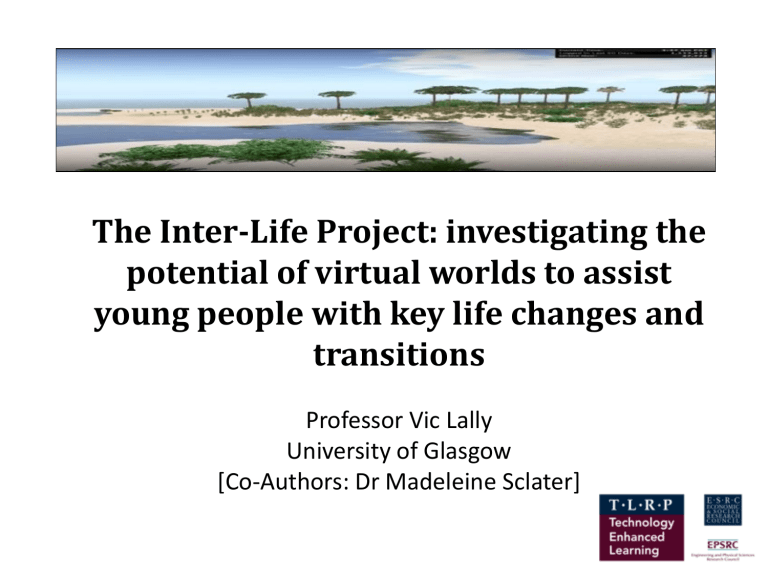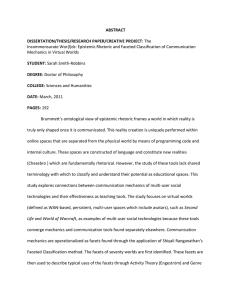The Inter-Life Project: investigating the potential of virtual worlds to assist

The Inter-Life Project: investigating the potential of virtual worlds to assist young people with key life changes and transitions
Professor Vic Lally
University of Glasgow
[Co-Authors: Dr Madeleine Sclater]
Overview
• Context of Research Project
• Aims & Research Questions
• How we addressed the research questions
• The way we worked
• Profile of the young people
• Theoretical perspectives informing the design of the research
• Methods and Methodologies
• What happened: Art and Design as a method of creative engagement
• Where next?
Background
• ESRC/EPSRC funded project called ‘Inter-Life’ (2008-2011)
• Funded under phase III of the Teaching and Learning
Research Programme (TLRP)
• Multi-disciplinary Team (of about 10 members) including
Education, Psychology, Computing Science, Art and Design
• University of Glasgow, with Heriot-Watt University, Stirling
University and University of Sheffield (UK)
• http://www.tlrp.org/tel/inter-life/
InterLife Island
Diary Room
Aims
• Inter-Life Island is a 3D multi-user environment
(based on Second Life ® ), with mobile device integration.
• The project is about enabling young people to acquire and develop skills to enhance life transitions (educational and social transitions/formal and informal) through a range of digital creative activities [film making & photography]
• The aim of the project is to investigate how 3D
Virtual Worlds (such as Second Life) can be used to support the development of these skills
Aims
“I think a lot of educational spaces that exist are deeply constrained by social, cultural and political forces that mostly don’t want them to be exploratory spaces and have very restricted views of knowledge creation and don’t want to accommodate a mixing of the social emotional and cognitive whereas I think a lot of our learning is a mixture of all three of those...and so as an educator I was attracted to Second Life as a space where that possibility exists…(1)”
Inter-Life Island
High Level Research Questions….
1. How can transitional change such as risk, conflict and goalsetting can be handled in the virtual world?
2. How do personas develop in the real and virtual worlds, and how might the personalisation of avatars assists this?
How does this map onto real life?
3. How can the flexible use of mobile technologies be employed to enhance the skill development for transitional experiences?
4. How can interoperability be successfully achieved between applications, documents and media?
And How We Address them
• We set up a Virtual Research Community involving young people working in partnership with members of the research team.
• We made available tools and resources to engage in personal and group projects
• We supported the development of creative activities with a focus on photography and film making
• We fostered collaborative activity
The way we worked
• We gathered (researchers and young people) together in a 3D space at an agreed time and introduced ourselves
• We spent time sharing aspects of our lives using photography & film, and to a lesser extent music
• We co-planned an agenda of activities relating to interests, personal concerns, hobbies and issues
• We conducted weekly meetings, sometimes supported by face to face contact (10-15 weeks)
• There were 2 communities with whom we worked.
Glasgow/Sheffield and Trinidad
Profile of the young people
• Glasgow/Sheffield collaboration - a mixture of young people in foster care or local authority homes (15-18 years) and their carers
• Trinidad – Young people (15-16 years) and their teacher
• All the young people, carers and researchers had an avatar each which represented them in the 3D world.
Theoretical Perspectives
Sources
• Communities of Practice (Wenger 1998)
• Paulo Freire ‘The Pedagogy of the Oppressed’
(1970);
• Karl Rogers ‘Freedom to Learn’ (1969)
Framework
We are using Activity Theory (Engestrom, 1987;
2001) as a means of providing (mostly) analytical coherence, focusing on groups of people working together in activity systems.
Activity Theory
• Helped us to focus on ‘activity systems’ and the spaces between them (boundary spaces)
• Helped to conceptualise emotions and identity as part of this
• Helped to focus on the development of shared objects, and – crucially – the skills, thinking and knowledge that developed alongside them
Methods and Methodology
• Phenomenographic Techniques: Gathering accounts of young people’s lived experience on
Interlife Island
• Mixed Method Data Analysis: Coding of textual dialogue, interviews, young person led tours, base line questionnaires and focus groups; Social
Network Analysis (SNA)
• Mixed-method, data gathering (textual chat, video
Data Analysis
• Coding a sample of workshops – beginning, middle and end
• Selecting ‘critical incidents’
• Developed a coding scheme to analyse data
• Triangulating data with interviews and participant led tours
Preliminary Results
• At the start of projects, analysis shows researchers leading and having a more dominant role than young people
• Later workshops reveal a deeper and more independent level of creative engagement in activity by the young people – a greater sense of agency on their part.
• Looking for instances of cognitive, metacognitive, affective and social learning
Preliminary Results
• The results reveal the processes of research community building and the emerging social network among the participants.
• The significance of these findings is set in the current dialogue about the role of technology in mediating social learning (Selwyn, 2010) and conversely the role of social learning in shaping appropriate technologies.
• The results start to show how the discussion, reflection, and rehearsal with avatars actually produces realistic and positive self help resolutions.
Results…
• A sense of place and group history was created
• The environment felt authentic
• Individual identity could be explored and changed through community activity and dialogue
• Enhancement of positive self image occurred
• Opportunities for ‘open action’ were created
Results…
• Conflict and dialogue were stimulated in the process of building groups, conceptualising and undertaking joint projects
• Exploration of emotional issues led to the motivation to find positive solutions
• High level problem solving skills developed
• These skills mapped across from the virtual to real worlds and back.
What happened
• Developing Codes of Conduct on Interlife
• Agenda Setting
• Introducing one another
• Sharing personal stories: bereavement
• Co-construction of the space
• Developing artefacts, tutorials, tours
• Development of collaborative videos
• Formation of research communities – developing new bonds
Developing an Agenda
Developing a Code of Conduct
Sharing personal stories
Introducing and Sharing
Meeting
Sapphire Cyberstar conducting a tour of the island
Sapphire re-inventing herself
Zac creating beginners guide
Zac taking a tour of the island
Summary
• In this project, we analyse how young people in a 'Virtual Research Community' (VRC) in InterLife, become 'co-researchers' in a suite of creative activities, supported by the Inter-Life team.
• These creative activities include photography, digital film making and collage. We argue that the research community participants’ desire to express themselves creatively through these activities, can help to address social issues facing individuals and schools, where their obvious skills and potential contributions may be under-utilised.
• This project investigates what happens when the Inter-Life Project helps pupils to act together in boundary spaces, harnessing and utilising the energy to develop and re-write their ‘personal narratives’
• 3 D worlds can be creative spaces where students and young people can take the lead supported by tutors/mentors but not lead by them. Blurring of boundaries between formal and informal learning.
• Significant unrealised potential of using 3D worlds for education, guidance, and training
Coding Schema Showing ‘High Level’ Codes
Table 1. Coded Utterance Values for Trinidad
Group Workshop 1 – ‘Beginnings’ (2/03/11)
Figure 3. Coded Utterance Values for Students –
Workshop 1
Table 2. Coded Utterance Values for Trinidad
Workshop 10 – ‘Endings’ (28/06/11)
Figure 5. Coded Utterance Values for Students –
Workshop 10






